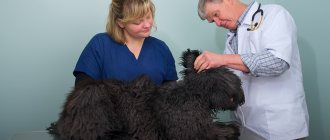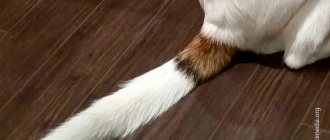If the dog itches a lot, most owners assume that the culprit is fleas - small blood-sucking brown or black insects that, in addition to itching, bring their pets a lot of other inconveniences in the form of anemia, skin inflammation, restless sleep and exhaustion.
But the reason for a pet’s constant scratching is not always due to the presence of fleas on its body. Itching can also be caused by other bloodsuckers, and even some diseases of the internal organs. In this article we will try to figure out why a dog itches if it doesn’t have fleas.
, what are the reasons for such a misfortune.
Possible causes of discomfort
Itching causes discomfort in the dog; it itches and pathogenic microorganisms and fungi can penetrate through the damage. The cause of itching can be:
- ectoparasites;
- allergic reaction of various etiologies;
- skin diseases;
- hyperfunction of the sebaceous glands;
- stress;
- systemic diseases - diseases of the reproductive system, malignant processes in the body, endocrine pathologies.
The owner of a dog can rarely independently determine the cause of itching; it is necessary to seek qualified help, since the disease can be caused by several reasons.
Collar irritation
New collars or collars that are too tight may cause your dog to rub his face and neck against the ground, furniture, or walls in an attempt to relieve discomfort.
If you get your dog a new collar, you should check it to make sure it is not too tight and does not chafe your dog's neck.
If your dog has had the collar on for a while and has grown or gained weight, it may now be too tight and need to be adjusted or removed.
You should be able to easily fit two fingers under your dog's collar.
Ectoparasites
Insects that parasitize animals include not only fleas, but also other arthropods - ticks, lice, lice.
Tick, louse, lice eater
After treating your pet for fleas, you cannot be completely sure that you managed to get rid of them. After all, flea eggs and larvae can remain on the dog’s bedding, in furniture upholstery and carpets. Therefore, you should once again examine the dog’s fur to identify eggs and adult fleas.
If the dog itches, but there are no fleas, it is worth examining the skin for the presence of other insects:
- mites: ixodid, gamas, subcutaneous (demodex), scabies, ear mites, etc.;
- lice eaters.
The Ixodid tick causes diseases such as piroplasmosis, ehrlichiosis, hemobartonillosis, and Lyme borelliosis. The secretion of the salivary glands of mites causes severe itching and scratching in dogs in the neck, ears, and head. There can be an allergic reaction to a tick and flea bite, which leads to rashes and itching. The dog itches all the time, causing damage to itself. Only a veterinarian can describe how to treat an animal for piroplasmosis.
The gamas mite parasitizes small animals (mice, rats) and birds (chickens, pigeons). The parasite can migrate to the dog's torso if there is no usual host nearby.
The subcutaneous mite is capable of parasitizing on the surface of the epidermis for a long time, feeding on horny scales. When immunity decreases, the mite penetrates deep into the skin, causing severe itching. The female lays eggs in the hair follicle, which becomes inflamed, forming a characteristic red rash. Demodicosis is most often noted on the dog's face. Itching causes scratching and red spots on the nose, around the mouth and eyes.
The scabies mite, which is called itching due to the symptom accompanying the infection, provokes scabies.
Subcutaneous mite
Interesting!
Itching occurs on a dog through prolonged contact of the skin of a healthy and sick animal. The insect is “screwed” under the skin and for this it needs at least half an hour. The animal is infected by an already fertilized female, who lays eggs in the outer layer of the skin. The emerging larvae actively move, gnawing passages, which is why the dog itches.
Ear mites parasitize the ears of cats and dogs, feeding on the secretions of the sebaceous glands and wax. Temporarily, until it gets into the ear canal, the insect can be on any part of the body, gnawing passages in the skin to get to the lymph. The affected area begins to itch very much, so the dog shakes its ears and begins to scratch them vigorously.
Any type of mite has symptoms both characteristic of a particular species and common to all, among which the main one is itching. Treatment includes local and systemic drugs. The complex is prescribed only by a veterinarian; self-medication can lead to serious consequences.
But infection with ticks, lice and fleas can be prevented by treating the dog with one of the medications in the form of spray Bars, Bolfo, Frontline, Defendog). The drops have proven themselves well.
- Frontline;
- Bars Forte;
- Barrier;
- Blokhnet;
- Advocate;
- Celandine;
- Advantix;
- Practitioner.
It is also recommended to put a collar on the animal (Kiltiks, Foresto, Celandine).
Products for dogs
Toothache
A sore tooth or other mouth pain may cause a dog to rub his face against something to relieve the pain. Dogs with toothache may eat less, want to eat only soft foods, or only chew on one side of their mouth.
Bad breath, bloody saliva, and repeated lip licking are other signs that may accompany muzzle rubbing in a dog that needs a tooth removed.
Some bad teeth may eventually fall out on their own, but this may take months or years and the dog will be in a lot of pain during this time.
Loose and broken teeth can also cause infection, which can affect organ function if left untreated.
Diseased teeth must be removed by a veterinarian, so medical attention is required if your dog rubs his face for this reason.
Allergic reaction to various irritants
If your dog is constantly itching and testing for fleas and other parasites is negative, you may suspect an allergy caused by the following factors:
- flea bites;
- substances entering the body by air;
- chemicals from hygiene products;
- food or its change;
- vaccines and vaccinations.
The human and dog bodies are very different and, despite the fact that the allergic components are similar and their mechanism of action is the same, the symptoms are different. In dogs, allergies are prolonged by itching and skin disorders. Subsequently, a secondary infection takes root at the site of severe scratching, which is accompanied by inflammation.
Fleas cause allergies, which is the body's reaction to a foreign protein that enters the bloodstream with the secretions of the insect's salivary glands. Even one flea caught on a dog can cause an allergy in the animal that once suffered from fleas.
Atopic dermatitis, which doctors estimate affects 4 to 16% of dogs, is caused by:
- plant pollen;
- household dust;
- excrement and particles of chitinous cover of synanthropic insects;
- mold fungi;
- dead particles of the epidermis;
- bird feathers and down.
Atopic dermatitis in dogs
Interesting!
When an allergen enters the body, it stimulates the formation of antibodies, the synthesis of which depends on genetic predisposition. Skin-sensitizing antibodies are formed in the cells, combining into antigen/reagent complexes. It is they and the bioactive substances released during the tissue reaction that lead to rashes, the feeling of “goosebumps” due to involuntary twitching of small muscles, and itching.
The dog often itches, especially in the area of the toes, belly, tail, and back. Red spots form under the fur, which are easy to notice, especially in short-haired dog breeds.
Food allergies are caused by proteins (anaphylaxis) or non-protein components of food (atopy). It is necessary to distinguish between intolerance to certain foods and true allergies, therefore, only a specialist can decide how to treat a food allergy after a differential diagnosis.
Allergens
Allergies in dogs are most often caused by foods such as horse meat, beef, and milk. The second group of allergenic products are soy, chicken, and lamb. Many premium foods contain these products. The allergy is accompanied by such severe itching that the dog itching, biting these places, can completely erase the incisors. At the site of severe licking, hair falls out, leading to complete baldness, discoloration of the coat, pyoderma, coarsening and hyperpigmentation of the epidermis.
In long-haired dogs, an allergic reaction provokes the development of a severe form of dermatitis. If the Pekingese itches, and on parts of the body the fur is noticeable, sticking together, as if from saliva, then the cause may be wet dermatitis. When cutting the wool, a very complex picture of pathology becomes visible.
Allergies can be triggered by the use of medications - eye and ear drops, vaccines, etc. The manifestations are the same as with other types of allergies. If your dog itches after taking flea drops, then it is highly likely that he is allergic to this product.
Dermatosis, which is accompanied by itching, can be caused by contact with the collar. This form of the disease is often observed in puppies, since their delicate skin is very sensitive to constant exposure to insecticides. The puppy is itching, trying to remove the collar.
To treat allergic reactions, veterinarians prescribe cortisone and other antihistamines that help relieve skin manifestations and itching (Benadryl, Tavist, Amitriptyline, Atarax).
Follow-up and prevention
The owner of the animal must carefully monitor the health of the pet, promptly contacting a veterinarian for help if he notices that the dog is itching. Preventive measures include maintaining good hygiene, constant washing and cleaning the bedding on which the animal sleeps. It is important to limit the animal’s contact with known sick and homeless animals. Do not forget about preventive measures of antiparasitic treatment and timely vaccination.
Author and presenter of the column: Veterinarian Nikolay Evgenievich Smirnov
Due to the large flow of incoming questions, free veterinary consultations are temporarily suspended.
Online diagnostic service for dog diseases >
Skin diseases
The dog itches a lot and with various skin diseases. The most common are lichen, wet or dry eczema, dermatoses.
Dermatophytosis in dogs
Dermatophytosis is often seen in puppies, young animals, and dogs with compromised immune systems. Mycoses cause not only itching, but also hair loss, nodular lesions of the skin, peeling and yellowing of the nails, peeling and cracking of the pads on the paws.
The doctor prescribes treatment of the body with antifungal agents - shampoos (Nizoral, Dermazol) or the drug for dogs Imaverol. For systemic treatment, the following drugs are used - Orungal (Itraconazole), Lamisil (Terbinafine), Nizoral, Oronazole (Ketoconazole).
In healthy dogs, dandruff is absent or invisible. Dandruff flakes can form under the influence of various factors that cause dry or oily seborrhea. When a Spitz itches or the itching bothers representatives of other “sofa” breeds, the cause is dry seborrhea. These animals are bathed frequently, which leads to dysfunction of the sebaceous glands and dry skin. Also, a lack of fat leads to the formation of dry dandruff. If the cause is not a fungal infection or systemic diseases, then the doctor prescribes antiseborrheic shampoos.
Inflammatory dermatitis often occurs in dogs with large folds of skin. If a pug itches, or a chow-chow, bulldog, or mastiff scratches its muzzle with its paws, then it is worth checking the folds, where you can detect redness of the skin and increased humidity, swelling and destruction of the epidermis.
Treatment of dermatoses begins with treatment with antibacterial, disinfectant detergents, and then treated with drying preparations. If the process is advanced, the doctor prescribes antibiotics.
Allergies as a source of itching
Allergies are one of the most difficult to determine causes of itching in dogs. If the animal's face or paws are constantly itching, spots are visible on the skin, the fur is breaking, and mucus is secreted from the nose, then the pet may be allergic to something. Almost everything that surrounds us contains substances that can cause allergic reactions, this can be food, dust particles, pollen, water and much more. In such a situation, self-medication is useless. A veterinarian will be able to immediately identify the substance causing the allergy by taking a blood test, but if such a measure does not yield anything, then further determination of the allergen occurs by excluding the likely primary sources of the disease.
Itching may occur due to the dog bathing in water with various impurities of metals, hard salts and other elements, as well as with low-quality detergent. If your pet develops dandruff, you should stop using shampoo and wash your pet in plain clean water. This will not only protect your dog's skin from damage, but will also wash away all the dust and dirt from the body.
Hyperfunction of the sebaceous glands
Greasy tail in dogs
Some dogs exhibit a pathology called “greasy tail.” This pathology is more common in cats, but can also occur in dogs. Hyperfunction of the sebaceous glands, located like a rosary on the upper surface of the tail and around its base, leads to sticking of the hair, the formation of black spots on the skin, and the appearance of oily seborrhea. Itching causes the dog to chew its tail, “ride” on its butt, and causes severe discomfort. A dog's licking of affected areas can cause alopecia or serious tail injuries.
Treatment consists of treating the wool with special shampoos to regulate the function of the sebaceous glands. Until the cause of hyperfunction is determined, this is the only method.
Carrying out diagnostics
Diagnostic measures in a veterinary clinic traditionally begin with an external examination and medical history. In the vast majority of cases, an experienced specialist can, with a high degree of probability, determine the possible cause of scabies based on external signs, such as the nature of the skin lesion, its location, and the presence of accompanying symptoms. Subsequently , depending on the presumptive diagnosis, clarifying examinations are prescribed, for example:
- blood test - clinical, biochemical, for parasites, etc.;
- microscopy of skin scrapings and the contents of ulcers (allows us to identify not only ectoparasites, but also other pathogens);
- trichoscopy (computer examination of wool and fluff);
- cytological examination of skin or conjunctival scrapings;
- microscopic and cytological examination of wool, incl. using a tape test;
- Wood's lamp examination is a specific procedure for shining a dog in a dark room with a special optical device, which makes it possible to detect trichophytosis and some other types of pathogenic fungi on the animal's skin;
- X-ray examination of the jaw (if gingivitis and other problems with teeth and gums are suspected);
- measurement of intraocular pressure (to diagnose ophthalmological problems);
- histobiopsy is a complex study used in cases where “faster” methods for diagnosing the nature of dermatological pathology have failed.
Did you know? In Moscow, at the Mendeleevskaya metro station, there is a bronze monument to a stray dog scratching its own ear with its hind paw. The pedestal, called “Sympathy,” is dedicated to the memory of a stray dog named Boy, who lived nearby in an underground passage and was brutally killed in 2001.
The greatest difficulties usually arise from diagnosing an allergy, or more precisely, its causative agent. In this situation, the elimination method, in particular the so-called elimination diet, is still considered the most effective. Its principle is to gradually remove from the diet one by one all components that can cause allergies. Once the animal's condition has stabilized, potential irritants are returned to the feed in the same, one-by-one manner. These peculiar “swings” sometimes make it possible to quite accurately establish a pattern between scabies and the product that was eaten by the animal the day before.
Stress
In dogs, the nervous system reacts to prolonged exposure to stress factors with various manifestations, including skin ones. Short-term factors - a visit to the doctor, injections, a sharp shout, an unpleasant strong odor - cause a reaction that disappears when the irritating factor disappears. Prolonged stress can lead to various external manifestations, including increased licking and biting of certain parts of the body due to allergies or seborrhea.
Treatment consists of eliminating the stress factor, providing positive emotions, and distraction. Occupational therapy brings a good therapeutic effect. For chronic stress, your doctor may prescribe sedatives.
Whatever causes the dog’s itching, the owner should pay close attention to this and promptly contact a veterinary hospital. Self-medication can not only cause serious consequences, but also miss the time required for a complete cure.
What to do if your dog itches all the time
If your pet scratches itself once or twice a day, then there is no reason to worry. And when the itching literally exhausts the animal? If your dog has lost peace and sleep, constantly scratching and licking his body, it’s time to take action. To relieve skin inflammation, animals are given corticosteroids (Cortisone, Dexamethasone, etc.), and antihistamines (Tavegil, Suprastin, etc.) to eliminate itching. Wounds on the body are treated with antiseptic drugs (Levomekol, Zinc ointment, etc.). If you are sure that the scratch is caused by the presence of parasites, insectoacaricidal agents are used (Advocate, BARS Forte, etc.).
But it is better not to carry out therapeutic measures on your own, since only a doctor can prescribe the correct treatment after examining the tailed patient and conducting the necessary studies (skin scrapings, culture, biopsy, biochemical blood test, etc.). Unfortunately, it will not be possible to determine “by eye” what the dog is sick with. The same sarcoptic mange can easily be confused with pyoderma or dermatitis. In addition, as we found out, itching of the skin, although atypical, is still a sign of some diseases of the endocrine, digestive and urinary systems, and here antihistamines, antiseptics and hormones alone cannot be used.
Why does he whine often?
Experiencing itchy skin, the puppy cannot tolerate it and, accordingly, tries to relieve it by scratching. The skin becomes injured and begins to hurt, which is why the puppy begins to whine and scratch himself even more, trying to get rid of the pain this time.
If your pet behaves this way, then you should definitely show it to the veterinarian. The earlier the disease is detected, the more effective its treatment will be.
Methods for treating dogs for itching without fleas
Methods for treating itching in the absence of parasites:
- with increased sensitivity. It is necessary to normalize the dog's nutrition. The modified diet should contain the optimal amount of various vitamins and minerals that your pet needs. It is also better to exclude your pet from eating meat for a while;
- with weeping lichen. You need to use special drugs, for example, Mercurius. Such products must be used according to instructions. As secondary measures, it is necessary to apply bandages with ointments and carry out water procedures. It’s better for your pet to forget about meat and potato dishes for a while;
- for dry lichen. Changes in skin color, rashes, peeling and itching are symptoms of lichen. In this case, it is necessary to isolate the pet from other animals and begin a medicinal course of treatment. You need to bathe your dog as often as possible with a mild, soothing soap, treating wounds with linseed oil. Add no more than 10 drops of Dulcamara 3 or Phosphorus 3 to food;
- for scabies and scabs. The diseases are too contagious, and because of this, the pet must be isolated from other animals. You should carry out water procedures with special creolin soap and linseed oils, change your pet’s diet;
- if you have a food allergy. It is necessary to ensure that the pet does not consume an allergenic product, which can be detected with the help of a veterinarian.
Most often, special means are used to treat itching:
- antihistamines. They can relieve your pet of itching only in 50% of cases. The only side effect may be drowsiness, but otherwise these drugs are safe. Typically, antihistamines are used in the absence of any serious diseases. May also be used for other allergic symptoms;
- fatty, natural acids. They are an auxiliary remedy that is used for minor illnesses;
- anti-inflammatory lotions and ointments. In some cases, ordinary cool water may have a similar effect;
- colloidal oatmeal. Has a strong anti-inflammatory effect and removes toxins from the body;
- sulfur-based solutions. They are versatile and effective. Such products dissolve proteins on the skin, but the downside is an unpleasant odor and a change in the color of the dog’s coat;
- anti-parasite shampoos. Such shampoos are very versatile, have a calming effect and are usually applied for a while and then washed off;
- solutions or sprays containing gum lac. There is no need to wash off such products, as they dry themselves after spraying. It is better to use together with a sulfur solution;
- corticosteroids. Such substances are used for particularly severe forms of disease. They have properties that negatively affect the body.
In addition, folk remedies can be used. You can relieve itching at home using cold herbal infusions: calendula, echinacea, comfrey. Aloe vera juice can also come to the rescue.
You can relieve your dog of itching during shedding using a special comb.
Dog owners should never forget about the help of veterinarians, because only they can give truly accurate and practical advice. Home treatment can only harm your four-legged friend. No one can make diagnoses in absentia, so if your pet has itching, feel free to take him to the veterinary clinic.
Ear mite
If your puppy is constantly itching and acting restless, as well as whining and shaking his head, then he may have picked up ear mites. Ear scabies can occur due to infection with a special type of mite, Otodectes cynotis. When they get into the ears, they feed on the dog’s blood. This disease is most often seen in cats, but dogs can also contract it from another infected animal.
Ear mites occur in adult dogs, but small breed dogs or puppies are especially susceptible to them because they have weak immune systems. Symptoms accompanying this disease:
- Dark purulent discharge from the ear canals.
- Itching appears.
- The animal tears the skin around the ears with its claws, causing wounds and bald spots.
- The dog is acting restless and shaking its head.
If you do not start treating the animal in time, then this sore can lead to complete loss of hearing, and in some cases, to the death of the pet.
Continues after processing
If you have just treated your puppy for fleas or put an anti-parasitic collar on him, it is normal for the itching to increase.
Insects begin to run over the animal’s body in search of salvation, thereby causing it even more discomfort. This is a temporary phenomenon that goes away with the destruction of pests (8-12 hours after treatment).
But sometimes, the cause of double itching is an allergy to one of the components of the anti-flea drug or its contact with open wounds (bites).











